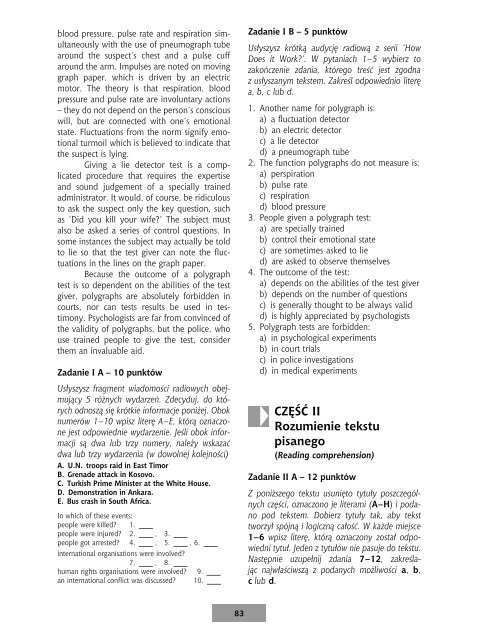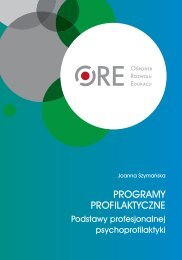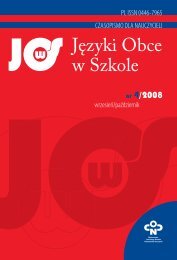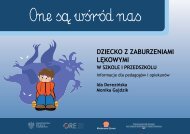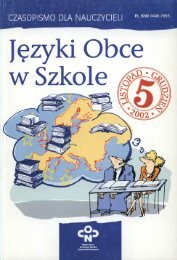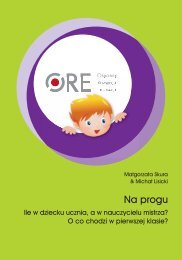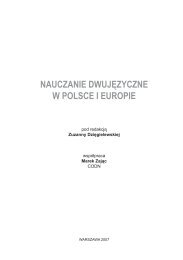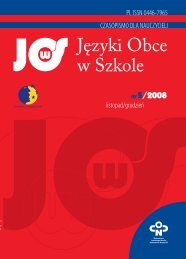PrzeglÄ daj publikacjÄ
PrzeglÄ daj publikacjÄ
PrzeglÄ daj publikacjÄ
Create successful ePaper yourself
Turn your PDF publications into a flip-book with our unique Google optimized e-Paper software.
lood pressure, pulse rate and respiration simultaneously<br />
with the use of pneumograph tube<br />
around the suspect’s chest and a pulse cuff<br />
around the arm. Impulses are noted on moving<br />
graph paper, which is driven by an electric<br />
motor. The theory is that respiration, blood<br />
pressure and pulse rate are involuntary actions<br />
– they do not depend on the person’s conscious<br />
will, but are connected with one’s emotional<br />
state. Fluctuations from the norm signify emotional<br />
turmoil which is believed to indicate that<br />
the suspect is lying.<br />
Giving a lie detector test is a complicated<br />
procedure that requires the expertise<br />
and sound judgement of a specially trained<br />
administrator. It would, of course, be ridiculous<br />
to ask the suspect only the key question, such<br />
as ’Did you kill your wife?’ The subject must<br />
also be asked a series of control questions. In<br />
some instances the subject may actually be told<br />
to lie so that the test giver can note the fluctuations<br />
in the lines on the graph paper.<br />
Because the outcome of a polygraph<br />
test is so dependent on the abilities of the test<br />
giver, polygraphs are absolutely forbidden in<br />
courts, nor can tests results be used in testimony.<br />
Psychologists are far from convinced of<br />
the validity of polygraphs, but the police, who<br />
use trained people to give the test, consider<br />
them an invaluable aid.<br />
Zadanie I A – 10 punktów<br />
Usłyszysz fragment wiadomości radiowych obejmujący<br />
5 różnych wydarzeń. Zdecyduj,do których<br />
odnoszą się krótkie informacje poniżej. Obok<br />
numerów 1–10 wpisz literę A–E,którą oznaczone<br />
jest odpowiednie wydarzenie. Jeśli obok informacji<br />
są dwa lub trzy numery,należy wskazać<br />
dwa lub trzy wydarzenia (w dowolnej kolejności)<br />
A. U.N. troops raid in East Timor<br />
B. Grenade attack in Kosovo.<br />
C. Turkish Prime Minister at the White House.<br />
D. Demonstration in Ankara.<br />
E. Bus crash in South Africa.<br />
In which of these events:<br />
people were killed? 1.<br />
people were injured? 2. , 3.<br />
people got arrested? 4. , 5. ,6.<br />
international organisations were involved?<br />
7. , 8.<br />
human rights organisations were involved? 9.<br />
an international conflict was discussed? 10.<br />
Zadanie I B – 5 punktów<br />
Usłyszysz krótką audycję radiową z serii ’How<br />
Does it Work?’. W pytaniach 1–5 wybierz to<br />
zakończenie zdania,którego treść jest zgodna<br />
z usłyszanym tekstem. Zakreśl odpowiednio literę<br />
a,b,c lub d.<br />
1. Another name for polygraph is:<br />
a) a fluctuation detector<br />
b) an electric detector<br />
c) a lie detector<br />
d) a pneumograph tube<br />
2. The function polygraphs do not measure is:<br />
a) perspiration<br />
b) pulse rate<br />
c) respiration<br />
d) blood pressure<br />
3. People given a polygraph test:<br />
a) are specially trained<br />
b) control their emotional state<br />
c) are sometimes asked to lie<br />
d) are asked to observe themselves<br />
4. The outcome of the test:<br />
a) depends on the abilities of the test giver<br />
b) depends on the number of questions<br />
c) is generally thought to be always valid<br />
d) is highly appreciated by psychologists<br />
5. Polygraph tests are forbidden:<br />
a) in psychological experiments<br />
b) in court trials<br />
c) in police investigations<br />
d) in medical experiments<br />
Ö<br />
CZĘŚĆ II<br />
Rozumienie tekstu<br />
pisanego<br />
(Reading comprehension)<br />
Zadanie II A – 12 punktów<br />
Z poniższego tekstu usunięto tytuły poszczególnych<br />
części,oznaczono je literami (A–H) i podano<br />
pod tekstem. Dobierz tytuły tak,aby tekst<br />
tworzył spójną i logiczną całość. W każde miejsce<br />
1–6 wpisz literę,którą oznaczony został odpowiedni<br />
tytuł. Jeden z tytułów nie pasuje do tekstu.<br />
Następnie uzupełnij zdania 7–12,zakreślając<br />
najwłaściwszą z podanych możliwości a, b,<br />
c lub d.<br />
83


